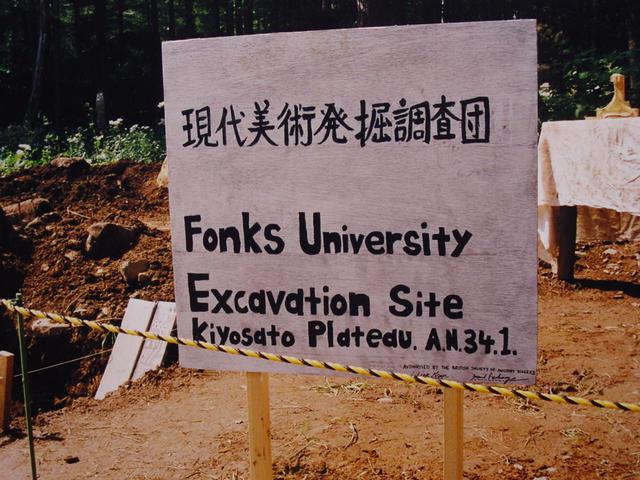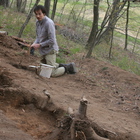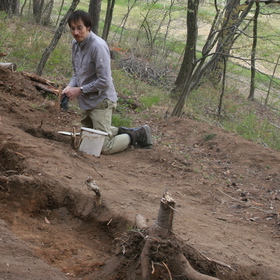穴(あるいは、僕のマネジメント論)

洞窟に住む男、すなわちこの聖なる存在は、
音が絶えず響き渡る/共鳴しあう暗闇の 世界から、光溢れる世俗的な世界へと向かうマーシャル・マクルーハン『グーテンベルグの銀河系』より
アートの中の、どこに穴があるのだろうか。最近までの美術史の調査では、絵の中に穴がわずかに描かれていたり、あるいはアーティストが穴を実際に作っていたことがわかったりしている。それはなぜだろう。ある人は、アートに穴のイメージがない理由を、象徴的かつ神秘的な理由によるもので、穴が死を想起させる世界への入り口、あるいは少なくとも、社会的に定義づけられている空間と対立する世界への入り口として捉えられているからだと推測するかもしれない。
キリスト教のしきたりにおいて、埋葬は、その最も明白でわかりやすい例である。墓堀人はある意味、周辺的な存在で、生死の世界の間にいる門番である。ひとたび、息が途絶えれば、肉体は土に還り、文字通り微生物となる。多くのアーティストたちが埋葬の場面を描き、特にキリストの埋葬は著しく多く描かれたが、ほとんど例外無く、これらはキリストの死体あるいはその周りで行われる儀式に焦点を充てたものだった。
日本のような仏教文化では、死は火、すなわち火葬とむすびつく。そのため、煙が立ち昇る空ともつながりがあるともいえる。火葬は、死体の状態が変形するスピードにおいて、埋葬とは決定的に異なる。火葬では、2時間あるいはそれより早く燃えて灰となるが、埋葬は、数か月もしくは数年かかって腐敗が進む。また、人体をミイラ化にすることは、火葬とは正反対の方法である。それは、火葬のように肉体を破壊するのではなく、その保存方法を探るものだ。1648年にニコラ・プッサンが描いた「フォキオンの灰」という風景画は、<火葬場の絵画>として珍しい例を示してくれる。これは、有名なアテネの将官の未亡人が、火葬された夫の灰を集めているという絵である。プッサンはそれを、彼女があたかも庭で野菜を育てているかのように描き、灰は、もはや土と一体になる。おそらくこれは、穴の正反対の表現で、そこでは肉体が塵となり、土という物質に近づいている。

グスタヴ・クールベの名作<オルナンの埋葬>(1849-50)は穴を描いた作品のなかでも、おそらく最も明解かつ、最も複雑なものだろう。クールベはこの絵のテーマについて、1851年に起きた共和制の崩壊に似たもの、そして、ロマンティシズムにおける埋葬へのシンボル、さらには形而上的なパトス(悲哀)と苦しみだと語っている。しかしながら私には、絵の主題が、その中にある大きく開いた穴だとしか考えられない。私たち鑑賞者は、実際には、穴の中から場面をみているのであり、その穴は、私たちの空間に向かってキャンバスの底が引っ張りだされている。穴が、絵に描かれているすべての人々に意識を向けさせる力を持つかのように、人々の意識は穴に集中している。たったひとつ、穴から目を背けているのは、人間ではなく、画面の手前で視線を右へそらす犬だった。画面後方には、十字架にはりつけにされたキリストが描かれ、象徴的に空に向かって高く持ち上げられている。それは、重力に逆らい、重力から解放された唯一の存在である。そして穴は、すべてのものが流れゆく先にある、お風呂の栓のような機能を持つように描かれている。さらに同じく画面後方に描かれた白い岸壁は、穴の空間の対照的な鏡のような働きをしている。そして、それらの自然と自然の間には人々が集まり、葬儀の儀式が行われている。この絵はまた、階級社会、権威、シンボルそして日々の出来事などの日常と社会の秩序をも描いている。そして、この絵に描かれている世界とは対照的に、穴は夢や想像の世界のハイパー空間としてそこに存在する。

私は、自然にできた穴や洞窟と、人為的な穴との間には、大きな違いがあるように思う。前者は、膨大な歴史とともに、人間が最初に創造したイメージにまでさかのぼって考えることができる。洞窟画、壁へのひっかき傷、彫られた骨。デヴィッド・ルイス=ウィリアムスは、『洞窟における心』というすばらしい書籍の中で、洞窟の深さと、意識の状態との間では類似性がみられると提唱する。洞窟の奥へ深く進めば進むほど、意識の状態が変化していく。地球の中心への旅はまた、例外無く心の内面への旅であり、社会空間から離れることである。
クリス・バーデンは、1979年に<正直な労働>という穴を掘る作品を制作した。バーデンの穴は重労働を示唆し、ミレーの農夫の作品との関連性があるようにみえる。1986年には<美術館の基礎を露出する>と題して、彼は美術館のなかに三つの穴を掘り、建物の基礎を実際に見せることで、美術館を批判した。穴を掘る行為を作品にすることは、1960年代や1970年代を通じて、多くのアーティストによってさまざまな規模で行われていた。マイケル・ハイザーの巨大なアースワークは、ブルドーザーを使った大規模なイベントで、さらには、クレス・オルデンバーグの<Placid Civic Monument, Central Park>(1967)やソル・ルウィットの<Buried Cube Containing an Object of Importance but Little Value>(1968)、あるいはスチュアート・ブリズリーの<Survival in Alien Circumstances, Documenta>(1977)は、実際に埋葬や発掘をすることで、身体との関係性がより強いものであった。


アーティストが穴を絵画に描くことに関していえば、戦後にそれが最も顕著に表れていたようにみえる。ルチオ・フォンタナは1940年代に、キャンバスの表面に切り込みをいれた「空間概念」という作品群を、具体の嶋本昭三は、1950年代はじめから中頃にかけて「穴」と題された作品を制作していた。ミラノのダダマイーノは、1950年代後半にキャンバスに巨大な穴をあけた作品を制作した。クールベの埋葬の作品とは反対に、これらは絵画という物質に対して、絵画にとってきわめて重要なキャンバスの表面を破り、それに批判的な攻撃を加えていたようにみえる。
ゴードン・マッタ-クラークは、1975年の弟の死後、1977年に最も感動的で興味深い穴作品のひとつである<Descending Steps for Batan>を制作し、パリのイヴォン・ランベール画廊で発表した。彼は毎日、ギャラリーの中で穴を掘った。それは、負のモニュメントであり、弟が眠る場所へ近づこうとする行為といえる。これは、ロダンによる彫刻の論理をさらに追求したもので、光や上昇する動きと決別し、カタコンベ、塵、ミミズのある地下へゆっくりと潜っていく。この作品は、人々が共有する社会空間からの離脱と洞窟空間への侵入を試みたクルト・シュヴィッターズのメルツバウとも関係がある。おもしろいことに両者は、動物たち(シュヴィッターズの場合はハムスター)、微生物や塵の粒子が飛び回る予測不可能性の領域に入り込もうとしていた。そして、日常空間という名の布に傷あるいは損傷を与えたいえる。不思議の国のアリスが、それまで暮らしていた場所から、奇妙な生き物が住むサイケ的なハイパー空間へ入ったように、ゴードン・マッタ=クラークはゆっくりと穴に落ちていく。

何らかの方法で土に還る作品、すなわちマクルーハンが語ったところの地下の共鳴空間へ戻ることは、音が反響し合う空間を再支配しようとする試みとして理解することができる。そしてそこでは、さまざまな文化モードや慣習的な行事を同時に経験することができる。つまりそれは、単一の文化モードや時間枠に定着させるのではなく、多様なアイデンティティーを含む声とともに共鳴する、常に複雑で相反する領域へ旅立つことを意味する。
この点において、美術館はある特定の文化モード、すなわち収集、保管、調査、展示と強く結びついているが、現在では、そこからの距離を保とうとする傾向がみられる。ただおもしろいことに、土と違って、ものが美術館に運び込まれるとすぐにそれは死に至り、そして死に続けることとなる。あるいは、美術館は少なくとも、ものは決して変化しないという神話を抱えている。結局のところ、美術館は組織であり、歴史を可視化するためには、むきだしの土から遠ざけなければならないとされている。すべてのものは、美術館の建物の中に収容され、展示ケースや額、保管庫に納められる。私たちがアートを鑑賞するときでさえも、キュレーションによる知識とガイドの説明に保護されている。
1998年に私が実現させた最初の展覧会は、日本の森の中に穴を作るというものだった。私は、展覧会というある種の統一感が求められるものに、個々のアーティストの作品の違いをどのように見せたらいいかという疑問に悩んでいた。そして、私の回答は、巨大な穴を掘り、その穴に埋める作品を作ることを彼らに依頼することだった。そして、展覧会の期間中に、毎日の<パフォーマンス>として作品を発掘することを提案した。作品が一度、土に還ることで、作品は私たちの生きる時空を離れ、土との間にもうひとつの契約を交わす。言い換えれば、作品は別の文脈をみつけ、キュレーターやアーティストの手から解放される。そして、キュレーションの母体は、偶然性と時間の経過に委ねられることとなる。
10年以上経っても、この展覧会は、強烈な経験として私の心に残った。私は、作品を埋葬する、すなわち、目の前の視界からそれを取り除き、微生物の領域である土に還すという、新しい美術館を構想した。おそらく、この美術館で作品を<見る>ことは、発掘の身体的かつ精神的な努力を自分に課すことを意味するだろう。訪問者は、あるものを泥からすくい、それが何かを不思議がり、百万通りの想像をめぐらせたあと、他の誰かがそれを見つけるためにまた土に還すだろう。

(2011年5月16日)
翻訳:塩見有子(マーシャル・マクルーハンの引用含む)

"The cave man or sacro-man emerges from the audio world of simultaneous resonances into the profane world of daylight." Marshall McLuhan, Gutenberg Galaxy
Where are the holes in art? A brief search through the history of art up to the present reveals a paucity of holes either depicted in pictures or actually created by artists. Why is this so? One may speculate that the lack of hole imagery in art may be due to their symbolic and mythical status as entrances to worlds associated with death, or at least counter-worlds to socially defined spaces.
In Christian traditions burial is the most obvious and relevant example. The grave-digger is a somewhat marginal figure, a gate-keeper, between the living social world and that of the dead. Once breath has ceased in a person, they are returned to the earth to literally become one again with its micro-organisms. Many artists have depicted burial scenes, notably of Christ, but almost without exception these pictures focus upon the deceased corpse or the ritual gathering which goes on around it.
In largely Buddhist cultures such as Japan, death is allied with fire, with cremation, and thus in a sense with the sky into which smoke rises. Cremation differs most significantly from burial in the speed with which the body is transformed. A corpse takes two hours or less to burn, whereas bodies take months or years to decay. Mummification is the most contrary method to cremation, seeking to conserve the body rather than destroy it. We have an unusual example of a 'cremation painting' in Nicolas Poussin's 1648 picture titled 'Landscape with the Ashes of Phocion' which shows the widow of a famous Athenian general gathering the cremated ashes of her husband. Poussin paints the woman as if she is tending vegetables in a garden, the ashes have become one with the earth. Maybe this is an inverse rendering of a hole where the human body has become dust and thus close to the materiality of soil.
Gustave Courbet's great painting 'Burial at Ornans' (1849-50) is perhaps the most explicit and most complex work which depicts a hole. Courbet spoke about this painting as an analogy for the fall of the Second Republic in 1851 and as a symbol for the burial of Romanticism and its themes of transcendental pathos and suffering. However, I cannot help but see the gaping hole as its principle subject. We the viewers are in fact watching the scene from within the hole, which stretches out of the bottom of the canvas into our space. I find it intriguing that all of the people present seem intently aware of the hole, as if it has captured their awareness. The only being which looks away is non-human, the dog in the foreground which gazes off to the right. Christ on the cross held aloft in the rear, symbolically rises upwards to the sky, the only one free from the oppressing pull of gravity. The hole is painted so that it functions almost like a bath plug, down into which all things eventually must pass. The white cliffs in the far background act as a kind of symmetrical mirror of the hole space, and in between these two natural domains gather humans, enacting rituals. The picture is also a depiction of the routines and order of society with its hierarchies, authorities, symbols and small everyday incidents. The hole contrasts with this world of culture, a metaphor for an Ur-space of dreams and imagination.
I suppose that there is an important distinction to be drawn between naturally occurring holes or caves, and human-made holes. The former occupies a vast history that extends back to the very earliest human made images. Cave art, scratchings, the carving of bone. David Lewis-Williams suggests a parallel between cave depth and different altered states of consciousness in his excellent book 'The Mind in the Cave'. The further in one goes, the further 'out' one was. Journey's into the centre of the earth are also invariably trips into the nether regions of the mind, remote from the known geographies of social spaces.
Chris Burden dug a hole in 1979 and called it 'Honest Labour'. Burden's hole suggests graft, hard work, and seems to reference the peasant pictures of Millet. In 1986 he dug three holes inside a museum, calling it 'Exposing the Foundation of the Museum', a critical comment on the institution. This literal digging of holes to make art continues through the nineteen sixties and seventies, in different scales. The massive earth works of Michael Heizer are immense bulldozed events while Claes Oldenberg's Placid Civic Monument, Central Park, 1967, Sol LeWitt's Buried Cube Containing an Object of Importance but Little Value, 1968 or Stuart Brisley's Survival in Alien Cirsumstances, Documenta 1977 reference the human body more directly through acts of burial and excavation.
In terms of painters painting holes, this avenue seems to become super literal in the post-war period, with Lucio Fontana breaking through the surface of the canvas in the late 1940s with his Spatial concept works (which admittedly point to metaphysical spaces of transcendence) and artists as diverse as the Gutai artist Shozo Shimamoto making a series of two dimensional works titled 'Holes' in the early to mid 1950s and the Milanese Dadamaino making large holes on canvas in the late 1950s. Contrary to Courbet's Burial painting, these works seem to be critical attacks on the physicality of painting, transgressing its essential surface.
Gordon Matta-Clark made what is one of the most poignant and interesting hole-works called 'Descending Steps for Batan' at the Yvon Lambert Gallery Paris in 1977, after the death of his brother in 1975. He dug daily down from the gallery space into the earth, a negative monument and an act of moving closer to where his brother perhaps was. This is a work which extends Rodin's sculptural logic to its extremes, turning away from Light and motion upwards, to slowly and physically enter an underground domain of catacombs, dust and worms. I relate this work to Kurt Schwitters Merzbau spaces, which also attempted an escape from shared social space into the constructed cave chambers of grottoes. Both artists interestingly attempt to slide into domains of unpredictability, where animals (guinea-pigs in Schwitters case), micro-organisms and dust particles play. Both artists managed to create lesions or scars in the fabric of everyday space. Gordon Matta-Clark slowly falls down the hole, like Alice, whose fall takes her farther from known quantities into a psychedelic hyper-space, populated by entities.
Works which have returned in some way to the soil, to the underground resonant spaces which McLuhan spoke of, can be understood as attempts to re-occupy the echo-chamber where simultaneous cultural modes and practices are experienced. Not to be fixed into a single cultural mode or time-frame, but always journeying out into complex, contradictory realms which echo with the voices of many identities.
In this regard the art museum is singularly rooted in specific cultural modes - of collecting, preserving, studying, displaying - from which it today is trying to find some distance. Interestingly, unlike the soil, once something enters a museum it dies, and continues to die. Or at least the myth of the museum is that things never change. After all the museum is an institution which has privileged precisely its distance from bare earth and soil in order to render history visible. Everything must be encased, from the outer-most layers of concrete and glass to display cases, frames and preservation chambers. Even the way we look at art is wrapped in vocabularies of curatorial scholarship and guidance.
My first exhibition making effort in 1998 was an exhibition made in a hole in a forest in Japan. I found myself vexed by the question of how to show the difference between artists works as an exhibition, which by its nature imposes a degree of unity. My answer was to dig a large hole, ask the artists to produce works which would be buried in it, and excavate the objects as a daily 'performance' during the exhibition period. I concluded that by once returning art to the earth, it temporarily leaves our space-time and enters into another contract with the soil. Or, to put it another way, the works find another context which exists beyond the horizon of the curator or the artists. Ideas about chance and time enter into the curatorial matrix.
Over a decade later, this experience remains the most lasting for me. I have imagined another kind of institution which buries art, removing it from the primacy of sight into the microbial domain of the soil. Perhaps to 'see' art in this institution means to commit oneself to the physical and mental effort of digging and excavation. The visitor scrapes dirt from something, wondering what it is and imagining it in a hundred million ways, only to return it once again to the soil for others to discover.
(16th May,2011)
[Author]
Roger McDonald PhD.
Born 1971 Tokyo Japan.
Deputy Director, AIT
Lecturer, Meiji University, Joshibi University
Independent Curator
Lives and works in Nagano.
[Upcoming schedule]
- AIT website
- E-MAD Online Art School course (I am main teacher)
[Links]
- arts initiative tokyo(AIT)
- The Tactical Museum
[My recommendation]
- Artists: Karin Ruggaber, Phoebe Unwin and Roger Ackling.
- Activity: Chopping firewood.
- Cooking: Pork with English mustard cream tomato paste sauce (Julia Childs recipe).
- Listening: Art critic Jerry Saltz talks on YouTube.
[Next author]
Mizuki Endo, Independent derector
Message
今後の予定
関連リンク
おすすめ!
- 作家:Karin Ruggaber, Phoebe Unwin and Roger Ackling.
- 活動:薪割り
- 料理:豚のイギリスマスタードクリームとトマトソース(Julia Childsのレシピ)
- リスニング:YouTubeのJerry Saltzの美術批評
次回執筆者
バトンタッチメッセージ
ハロー。元気ですか。農業のほうはどう?
ネットTAMに原稿を書いてくれないかと思って。
なんでもいいらしいんだ。それに謝礼も少しでる。
僕は、穴について書いた。というのも、最近このことについてよく考えているから。
今、庭にも穴を掘っているところなんだ。
多分、無意識にシェルターを作ろうとしてるのかも?
とにかく、もし君が書いてくれたらいいんだけど。
親愛をこめて。
ロジャー
Dear Mizuki,
Hello. I hope you are keeping well. How is the farming? I wonder if you would be interested to write for Net TAM website after me?
It can be on anything. There is a little payment also. I wrote about Holes, which I am thinking about a lot these days. I am digging holes now in our garden. Maybe it is a subconscious shelter building activity? Anyway, it would be nice if you could write.
My best always
Roger


